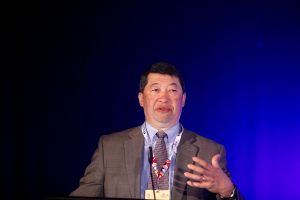
David Chang MD
From humble beginnings as a small clinic with just 11 beds and the modest goal of curing preventable blindness, the Aravind Eye Care System in southern India has grown into the largest eye care provider in the world and serves as a role model for how cataract blindness might effectively be eliminated in the developing world, said David F. Chang in his Ridley Medal Lecture at the 38th Congress of the ESCRS.
“I have long felt that our single greatest challenge in ocular surgery was not the invention of an accommodating IOL but rather the rapidly increasing backlog of cataract blindness in the developing world, which accounts for half of all global blindness,” he said.
Reflecting on his own association with Aravind which dates back to 2003, Dr Chang, Clinical Professor at the University of California, San Francisco, said that there are many lessons to be learnt from the Aravind model of providing large volume, high quality and affordable care through its network of 13 eye hospitals and 75 primary eye care facilities.
A critical component of Aravind’s model is high patient volume, which brings with it the benefits of economies of scale, noted Dr Chang.
Aravind’s unique assembly-line approach, with rates often exceeding 14 to 16 cases per hour per surgeon, increases productivity but without compromising on safety or quality. Every patient receives the same high-quality care and service, regardless of their economic status, he said.
“When I first saw this, I marvelled at how well choreographed it all was. Around 40% of private paying patients subsidise eye care for the other 60% who receive services either free of cost or at a steeply subsidised rate, yet the organisation remains financially self-sustainable. The message is that we can use this type of cost-recovery model to reduce and eventually eliminate global cataract blindness,” he said.
At the heart of Aravind’s approach to eye care is the use of sutureless manual small-incision cataract surgery (MSICS) explained Dr Chang. The technique uses a long, temporal, scleral-pocket incision which is wide enough to enable manual extraction of the undivided nucleus, after which a low-cost PMMA IOL is implanted. The incision is self-sealing, requires no sutures and is very fast to perform for an experienced surgeon.
Large-scale studies at Aravind show that the complication rate for MSICS is lower than phacoemulsification when the surgeon has less experience, and comparable for both procedures for experienced surgeons.
Published studies from Aravind have also shown that a squared posterior optic edge reduces PCO regardless of IOL material, said Dr Chang. This is important in developing countries where posterior capsular opacification (PCO) is a leading cause of visual impairment.
Other lessons to emerge from the Aravind experience are that intracameral moxifloxacin is safe and effective for endophthalmitis prophylaxis, and that cumbersome operating room regulations in developed countries regarding single-use supplies and devices may actually be of unproven benefit in reducing infection rates, he concluded.

 David Chang MD
David Chang MD